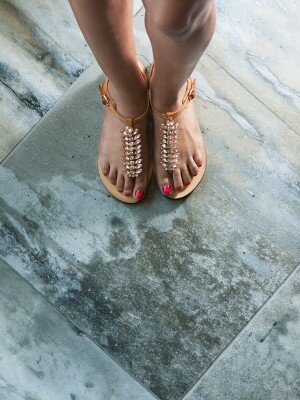-
Dressing table makeover
April 22, 2013
Add instant sophistication to a simple piece of furnitur.
Quick project guide
Hard labour 7/10 (constructing the table requires hard labour)
Skill level 6/10 (foiling is delicate work that requires concentration)
Time needed weekend project
Do it yourself for ±R600Project notes
• The components for the tabletop were cut from 16mm supawood, while the legs were cut from 220mm x 22mm pine.
• Silver or gold leaf is very delicate and requires a degree of patience; apply one or two sheets to another surface in order to get the ‘feel’ for it before moving on to the intended workpiece.Shopping listTabletop
• two 1200mm x 450mm x 16mm (top and bottom panels)
• two 1168mm x 120mm x 16mm (long sides)
• two 386mm x 120mm x 16mm (side panels)
• four 120mm x 120mm x 16mmLegs
• four 632mm x 220mm x 22mmOther items
• professional wood glue
• ±forty 6mm x 40mm cut screws
• wood filler
• spray can of contact adhesive
• silver or gold leaf (available at most craft shops for about R65 for 25 10 x 10cm sheets)
• goldfinger varnish – protects decorative metallic finishes
• foiling or goat’s hair brush
• foam roller
• multisurface primer
• water-based enamel/acrylic PVA (for the legs)Get started
1 First make the tabletop: measure and mark out 16mm-wide bands at both ends of the long sides (1168mm x 120mm x 16mm). Use cut screws and glue to construct the frame,. Use a combination square to make sure all angles are at 90º, with the longer sides overlapping the shorter sides.
2 Fill all the screw holes and blemishes using the wood filler. Paint structure with a coat of multi-surface primer.
3 Add profile detail to the edges of the top and bottom panels by using a router and bit, then paint with primer and PVA.
4 Once the primer has dried, apply a thin coat of spray contact adhesive to the sides of the framework.
5 Carefully separate the sheets of silver leaf before applying to the sides of the frame.
6 Place the bottom of the sheet onto the (slightly tacky) surface. Gently work the foil against the outside of the framework.
7 Use the brush to ‘dab’ at the edges and joins. Finally, apply the goldfinger varnish.
8 Mark out the shape of the legs on the 220mm x 22mm planks, then use the jigsaw to cut these out.
9 Place the top of each leg, in turn, in position (diagonally across the corners) and trace the outline onto the 120mm x 120mm leg supports.
10 Fix the legs to the supports by drilling pilot holes and screwing from the top. Paint the legs using a primer, followed by the colour of your choice.
11 Fix the legs to the base of the tabletop framework.
12 Position the framework onto the base, drill pilot holes and secure from underneath. Place the tabletop onto the structure, ensuring there is an equal overhang all round and trace the outline. Turn the top over and fix four offcut pieces of wood 16mm from this line, to prevent it slipping.



